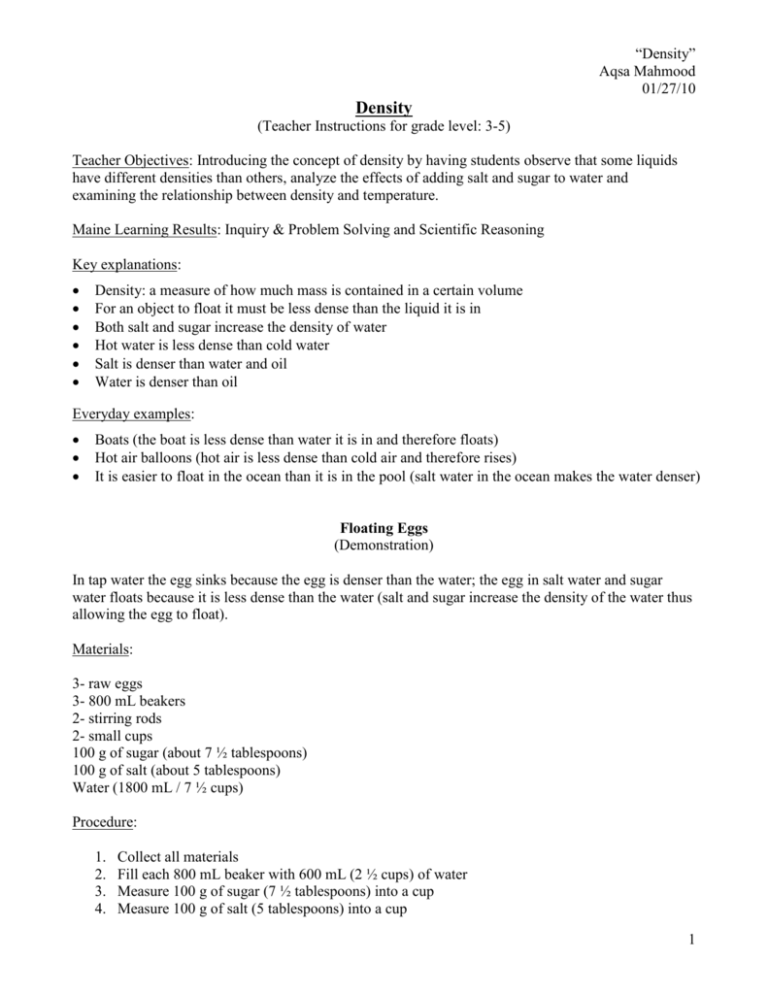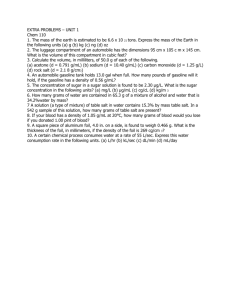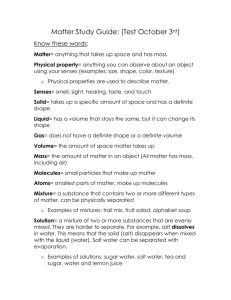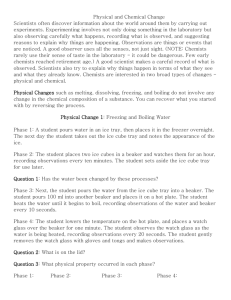Density Demos
advertisement

“Density” Aqsa Mahmood 01/27/10 Density (Teacher Instructions for grade level: 3-5) Teacher Objectives: Introducing the concept of density by having students observe that some liquids have different densities than others, analyze the effects of adding salt and sugar to water and examining the relationship between density and temperature. Maine Learning Results: Inquiry & Problem Solving and Scientific Reasoning Key explanations: Density: a measure of how much mass is contained in a certain volume For an object to float it must be less dense than the liquid it is in Both salt and sugar increase the density of water Hot water is less dense than cold water Salt is denser than water and oil Water is denser than oil Everyday examples: Boats (the boat is less dense than water it is in and therefore floats) Hot air balloons (hot air is less dense than cold air and therefore rises) It is easier to float in the ocean than it is in the pool (salt water in the ocean makes the water denser) Floating Eggs (Demonstration) In tap water the egg sinks because the egg is denser than the water; the egg in salt water and sugar water floats because it is less dense than the water (salt and sugar increase the density of the water thus allowing the egg to float). Materials: 3- raw eggs 3- 800 mL beakers 2- stirring rods 2- small cups 100 g of sugar (about 7 ½ tablespoons) 100 g of salt (about 5 tablespoons) Water (1800 mL / 7 ½ cups) Procedure: 1. 2. 3. 4. Collect all materials Fill each 800 mL beaker with 600 mL (2 ½ cups) of water Measure 100 g of sugar (7 ½ tablespoons) into a cup Measure 100 g of salt (5 tablespoons) into a cup 1 5. 6. 7. 8. “Density” Aqsa Mahmood 01/27/10 Pour the sugar into one of the 800 mL beakers and stir the sugar in the water until the sugar has dissolved [make a note that this beaker contains sugar] Pour the salt into the other 800 mL beaker and stir the salt in the water until the salt has dissolved [make a note that this beaker contains salt] Place one egg in each of the beakers Record your observations Underwater Volcano Hot water is less dense than cold water; therefore, hot water rises to the top of the beaker like lava from an erupting volcano. Materials: 800 mL beaker 10 mL vial Stirring Rod Red food coloring Aluminum foil String Cold Water (700 mL / 3 cups) Hot Water (10 mL) Water boiler Procedure: 1. 2. 3. 4. 5. 6. Collect all materials Fill the 800 mL beaker with 700 mL (3 cups) of cold water Fill the 10 mL vial with hot water and add about four drops of red food coloring Quickly place enough aluminum foil to cover the top of the vial (2”x2” is enough) Cut a one foot piece of string Using the string tie around the top of the vial twice and make sure you leave enough string to allow you to complete the next step 7. Place the vial into the bottom of the beaker 8. Using the stirring rod poke a big hole through the vial 9. Record your observations Lava Lamp Oil is less dense than water and salt is denser than both the water and oil. As the salt is sprinkled over the oil it coats the oil and weighs the oil down. As the salt sinks to the bottom the oil separates and floats back to the top. Materials: 250 mL cylinder (or empty plastic water or soda bottle) 40 mL of vegetable oil (¼ cup) 2 “Density” Aqsa Mahmood 01/27/10 25 g of salt (1 ½ tablespoons) Red/blue/green food coloring 2- Cups Water (for cylinder: 150 mL/ ⅔ cup) (for water bottle: 480 mL/ 2 cups) Procedure: 1. Collect all materials 2. Fill the 250 mL cylinder with 150 mL (⅔ cup) of water; if you are using the water/soda bottle fill the bottle with 480 mL (2 cups) of water 3. Add one to two drops of the yellow food coloring to the water 4. Measure out 40 mL (¼ cup) of oil and slowly pour it into the cylinder (or water/soda bottle) 5. Measure 25 g of salt (1 ½ tablespoons) and place it into a small cup 6. Slowly sprinkle the salt into the cylinder (or water/soda bottle) 7. Record your observations Total time: 60 min References: http://www.elmhurst.edu/~chm/demos/index.html 3 “Density” Aqsa Mahmood 01/27/10 NAME __________________________________________ DENSITY 1) What is density? (Circle the correct answer) a) a measure of volume b) a measure of how much mass is in a certain volume c) a measure of how much water there is in a container 2) For an object to float it has to be ___________ dense than the liquid it is in. 3) Why do you think the egg floated in the salt water and the sugar water? 4) Did the salt make the water denser or less dense? What about the sugar? 5) What did you see during the underwater volcano experiment? 4 “Density” Aqsa Mahmood 01/27/10 6) Why do you think the red water rose up and out of the little bottle? 7) Hot water is ___________ dense than cold water. 8) Write where you think the water, oil and salt will stay 9) In the lava lamp experiment what had the most density? What had the least density? 5 “Density” Aqsa Mahmood 01/27/10 10) Write where the water, oil and salt stayed in the cylinder 11) Oil is ___________ dense than water. 12) Water is ___________ dense than salt. 13) Salt is ___________ dense than water. 14) Salt is ___________ dense than oil. 6








